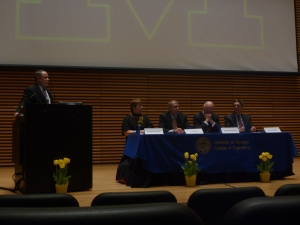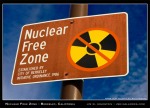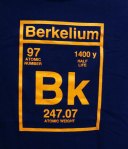Early in my involvement with the nuclear side of social media, I came across a rather outspoken anti-nuclear website called “Nuclear Reaction”. As someone who speaks her mind perhaps a little too often, I understand and fully support the need to express one’s opinions. However when one is expressing their opinions and presenting them as facts, I grow a little concerned. The site is a weblog hosted by Greenpeace, and there is hearty disclaimer on the site making it clear that the opinions expressed there are those of the writers alone, not of Greenpeace as an organization. But all the same, (and this is my opinion here), I think that if you have a website with your logo up in the corner and your name in the domain, you’re making it pretty clear where you stand on those opinions. Therefore I’m disappointed that such an influential and environmentally friendly group chooses to tear down the one clean energy source which has a chance at providing for the world’s growing energy needs.
Now I would love to go through each post on the site and refute it point by point, but frankly, I’m a Cal student and don’t have that kind of time. So I’ll start with one entry that had me particularly riled. Here’s a copy of the posting.
Hello, and welcome to Nuclear Reaction’s Nuclear Glossary. In this occasional series we’ll be bringing you a handy cut-out-and-keep guide to what the nuclear industry says and what the nuclear industry actually means. Never again will you be confused, fooled or otherwise misled by nuclear industry propaganda, greenwash and false promises.
What they say: ‘Safe’
What they mean: ‘Produces vast amounts of dangerous waste that will be a burden for the next 240,000 years to while dispersing dangerous radionuclides into the environment.’
What they say: ‘Cheap’
What they mean: ‘Hardly affordable even with government subsidies and loan guarantees’
What they say: ‘We believe nuclear is competitive’
What they mean: ‘New nuclear power stations will not be built in Britain unless the government provides financial support for the industry’
What they say: ‘Learning Curve’
What they mean: ‘Massive cost and schedule overruns, safety violations, design concerns, and thousands of construction defects’
What they say: ‘Reliable’
What they mean: ‘Unreliable
—————————————
Oh boy. Where to begin.
‘Safe’
So they have these handy links on the blog to let you see where they’re getting their information from. Curious as to where they got their “scientific facts”, I clicked on the “What they mean” link for this one, and they sent me to another Greenpeace blog. I figured there had to be more, so I clicked a link from that one and they sent me to yet another Greenpeace blog. I finally gave up and decided that the information was in fact not based on any science at all. Therefore I don’t have much to refute, but I’ll give you some facts on safety in the nuclear industry.
If you read my last blog post, you will find all the resources pointing you to the studies done on safety in the nuclear industry, so I won’t repeat the details. But in a nutshell, nuclear power is so incredibly well-regulated that plants around the world have impeccable safety records, and you’re safer working there than almost anywhere else.
As for the waste, I understand that there is concern. However I find that some statistics and comparisons help put things into perspective. Some of these statistics can be found in my “Arm Yourself” posting. You can find many others here: http://www.whatisnuclear.com/articles/waste.html. It’s important to know that over 90% of radioactive waste is capable of being reprocessed, and several countries around the world are already taking advantage of this option. Since the longest lived isotopes can be recycled through this process, the remains are only radioactive for a couple hundred years, not a couple hundred thousand. This would be an obvious solution if it weren’t for the fear of proliferation. However there are recycling methods without the risk of proliferation, and more research is going into these methods all the time.
‘Cheap’
While expensive initially because of construction and myriad permits and regulations, nuclear power plants become profitable in just a few years of running and provide some of the cheapest energy out there. If you don’t believe me, here are the production costs of electricity in 2008 in cents per kWh:
Coal: 2.75 Gas: 8.09 Petroleum: 17.26 Nuclear: 1.87
This information via Rod Adams and the Nuclear Energy Institute: http://www.nei.org/resourcesandstats/documentlibrary/reliableandaffordableenergy/graphicsandcharts/uselectricityproductioncosts/
‘We believe nuclear is competitive’
In this section, they seem to be referring to the politics of nuclear power in Britain, which I do not claim to know much about. Therefore, I will not address the British nuclear industry in particular. I will however speak for a moment to the competitiveness of nuclear power on a global scale. As of January 2010, there are 56 nuclear power plants in construction worldwide, and many, many more in the earlier planning stages. Despite hefty construction and permit costs, nuclear plants continue to spring up and be profitable, providing cheap, clean energy. So In my opinion, nuclear is a highly competitive energy source and is in fact the only clean energy source capable of being competitive on the greater energy scale at all.
‘Learning Curve’
Now this one really got me. I again clicked on the link they provided and this time it didn’t even send me to a particular article, it sent me to a google search of “olkiluoto”. Guess what came up on the search? 10 different blog posts about how terrible things are going over in Finland, all written by (you guessed it) Greenpeace bloggers. So frankly I find no evidence of what they claim and therefore am only going to refute it by recommending that you check out the “What they say” link (http://us.arevablog.com/2009/05/29/nuclear-renaissance-is-just-fine-thank-you/) which is actually a quite informative blog piece from Areva.
‘Reliable’
Despite the well-articulated “what they mean” response for this one, I see no truth behind the statement that nuclear power is unreliable. Again, this is where the raw data speaks for itself. In 2009, 13 American units generated more than 10 billion kWh of electricity, and 14 units had capacity factors of over 100%, which means that the amount of power put out was greater than what was expected of a plant operating at full capacity the entire year. And the greatest part is, the technology is only improving. Units in nuclear plants in 2009 broke world records, one of which is the longest run between refueling outages for pressurized water reactors. Calvert Cliffs 2 in Maryland ran for almost 2 years without needing refueling. Pretty tough to call that unreliable.
All of this simply goes to show that the nuclear industry’s biggest obstacle is ignorance. When so much false information is presented as scientific fact, what are we supposed to believe? But with a little more research, I think that you’ll always find that nuclear is the safer, cleaner, and more reliable choice. The truth lies in the physical facts, and that’s where we need to turn when in doubt. All it takes is few misguided people passing on misinformation, and the fear continues to spread. Nuclear reaction, indeed.





 Last weekend, I was fortunate enough to attend the ANS National Student Conference at the University of Michigan. To give you an idea of the sheer volume of this conference, let’s start with some numbers:
Last weekend, I was fortunate enough to attend the ANS National Student Conference at the University of Michigan. To give you an idea of the sheer volume of this conference, let’s start with some numbers:

